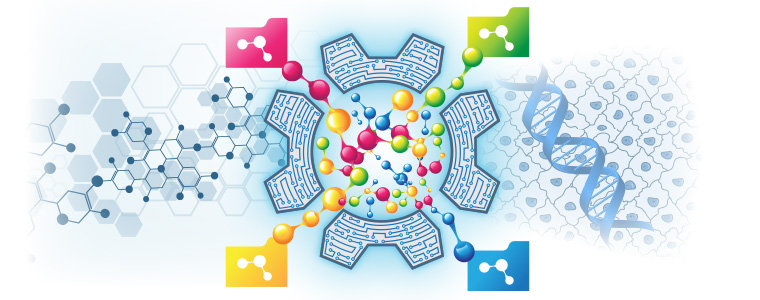Applications to Investigate Adverse Effects of Chemicals on Human Health and Environment Workshop
October 3-4, 2022 • 8:30 a.m. – 4:00 p.m. EDT

Main Purpose
This 2-day virtual workshop was part of the NIEHS/DTT scientific outreach activities to discuss Clustering and Classification Methods (and related cheminformatic tools as part of New Approach Methodologies (NAM)s) and their applications to facilitate toxicology research and provide information for risk assessment. The workshop introduced the concept of similarity and the different classification and clustering approaches as well as their uses for scientific toxicity research and risk assessment. The invited speakers and expert discussants helped to identify best practices and guidelines for the application of these approaches. Participation from attendees to round table discussions was encouraged.
This workshop was supported by the DTT/NIEHS Consumer Products and Therapeutics Program, which has a goal of developing and applying define approaches to infer hazard across specific structural and functional substance classes.
Workshop Goals
- Increase communication and collaboration from different sectors: government, academia and industry (US & international).
- To educate and correct misconceptions and develop new ideas/concepts (best practices & innovation).
- To introduce the different classification and clustering approaches and their uses for scientific toxicity research and risk assessment.
- To involve both NAM developers and users (regulators, researchers) to increase benefit and exchange.
Agenda
Day 1: Monday, October 3, 2022
Introduction
Session 1 (8:45 – 11:45 a.m. EDT): Chemicals and Similarity: Structures and Bioactivity
This session provided an introduction covering chemical structures and the concept of similarity from a structural, biological, phenotypic, and mechanistic perspective, including how similarity matters and depends on the context and goal in research and regulatory assessment. It also included a discussion on the concept of activity cliffs and cases where subtle differences in structural characteristics can lead to orders of magnitude differences in biological activity.
Speakers
- José Medina-Franco, Universidad Nacional Autónoma de México
- Esther Kellenberger, Université de Strasbourg
- Andrea Mauri, Alvascience
Round Table Discussants
- Alexandre Varnek, Université de Strasbourg
- Cathy Lester, The Procter & Gamble Company
- Huixiao Hong, U.S. Food and Drug Administration, National Center for Toxicological Research
Session 2 (12:30 – 3:30 p.m. EDT): Supervised and Unsupervised Approaches
This session defined and redefined terms ranging from molecular descriptors, fingerprints, tox alerts, machine learning, read-across, QSAR, univariate/multivariate analysis, classification, clustering, etc. and gave an introduction to the general theory of supervised and unsupervised learning approaches, covering the concept of analogues and surrogates and how to select the right ones depending on the goal and context.
Speakers
- Andreas Bender, University of Cambridge
- Davide Ballabio, Università degli Studi di Milano-Bicocca
- Denis Fourches, Oerth Bio
Round Table Discussants
- Thomas Luechtefeld, Insilica
- Alexander Sedykh, Sciome LLC
- Elena Fioravanzo, ToxNavigation
Day 1 Wrap-up
Day 2: Tuesday, October 4, 2022
Introduction
Session 3 (8:45 – 11:45 a.m. EDT): How and When to Apply the Different Approaches
This session provided an overview of the different possible applications of supervised and unsupervised clustering and classification approaches and how to apply them, separately or in combination, and interpret results. This session was important for a discussion on best practices.
Speakers
- Alexander Tropsha, University of North Carolina at Chapel Hill
- Alessandra Roncaglioni, Istituto Mario Negri
- Todd Martin, U.S. Environmental Protection Agency
Round Table Discussants
- Gilles Marcou, Université de Strasbourg
- Arianna Bassan, Innovatune
- Tomasz Sobanski, European Chemicals Agency
Session 4 (12:30 – 3:30 p.m. EDT): Applications and Examples
The last session provided examples of applications of different approaches for research and regulatory assessment uses.
Speakers
- Andrea Gissi, European Chemicals Agency
- Grace Patlewicz, U.S. Environmental Protection Agency
- Andrew Rooney and Suril Mehta, NIEHS, and Charles Bevington, U.S. Consumer Product Safety Commission
Round Table Discussants
- Lauren Zeise, California Office of Environmental Health Hazard Assessment
- Gino Sarcano, U.S. Environmental Protection Agency
- Patra Volarath, U.S. Food and Drug Administration, Center for Drug Evaluation and Research
- William Bisson, Inotiv
Day 2 Wrap-up and Adjourn
Workshop Planning Committee Members
Kamel Mansouri (Chair)
Vicki Sutherland (Co-chair)
Scott Auerbach
Stephen Ferguson
Rachel Frawley
Jui-Hua Hsieh
Gloria Janke
Nicole Kleinstreuer
Suril Mehta
Fred Parham
Cynthia Rider
Andrew Rooney
Kyla Taylor
Amy Wang
Questions?
For questions about the workshop content, please contact Kamel Mansouri at 984-287-3187.


